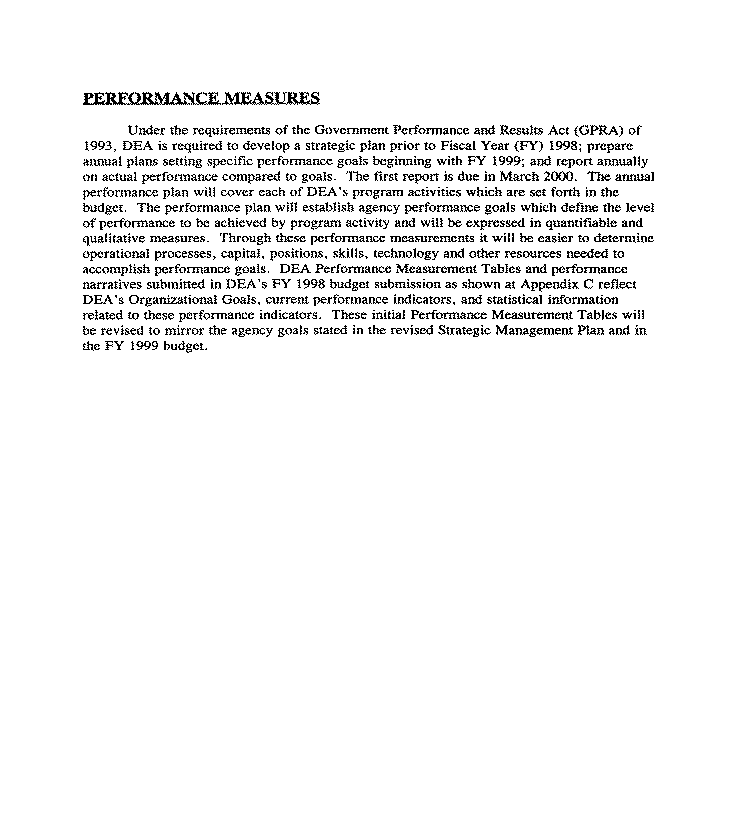
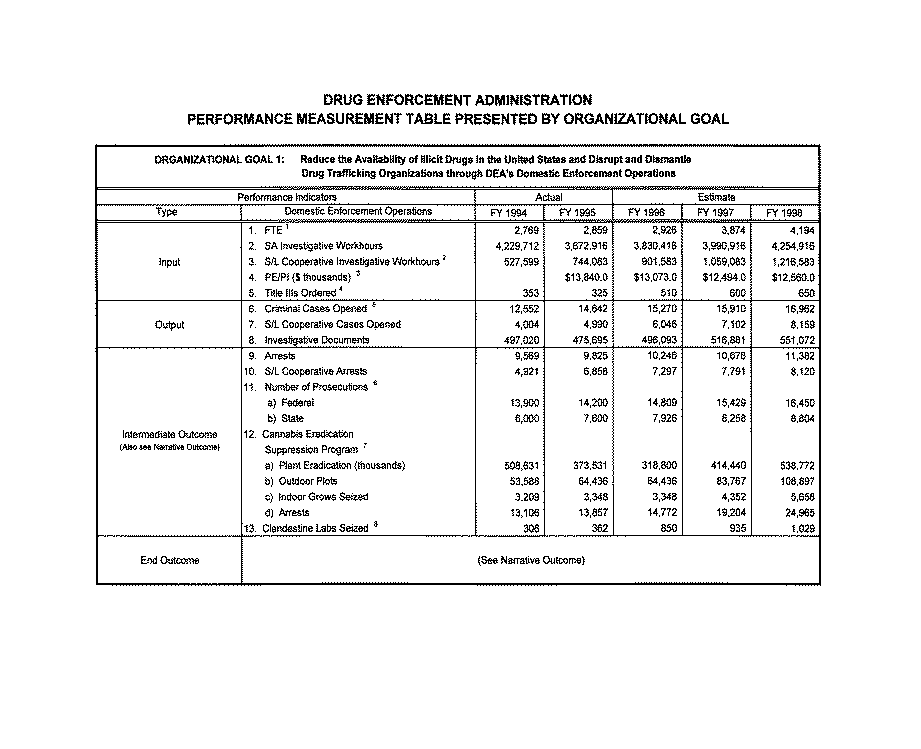
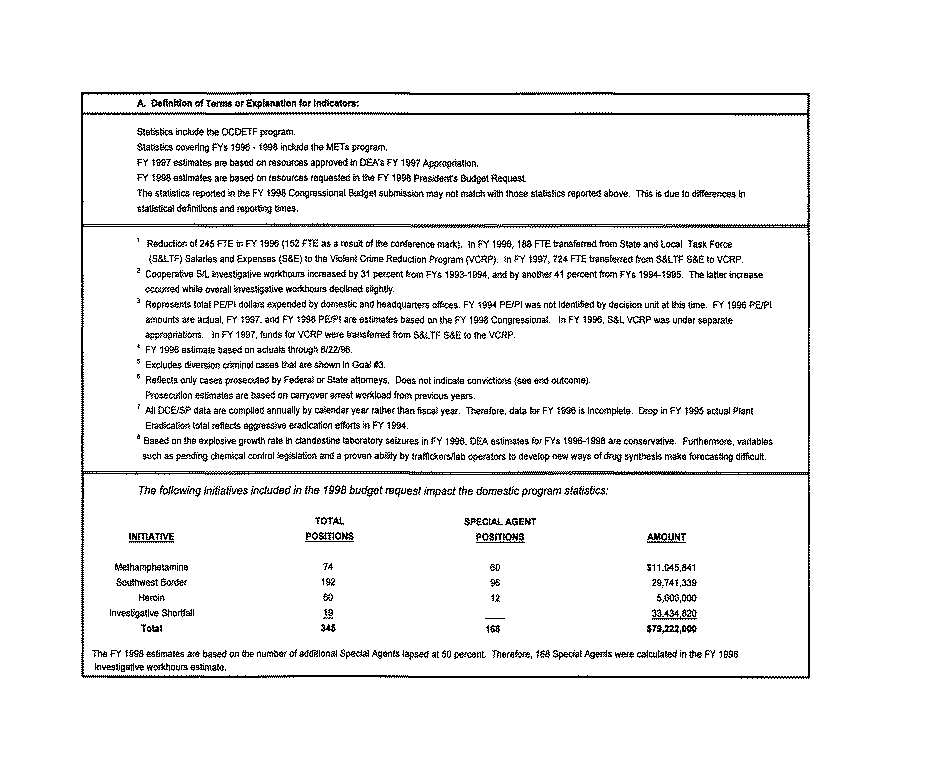 DOMESTIC
ENFORCEMENT ACTIVITIES
DOMESTIC
ENFORCEMENT ACTIVITIES


 DOMESTIC
ENFORCEMENT ACTIVITIES
DOMESTIC
ENFORCEMENT ACTIVITIES
NARRATIVE OUTCOME
The DEA's domestic enforcement activities have had a tremendous impact on drug trafficking and violence in communities throughout the United States. Below are recent examples of domestic law enforcement.
Zorro II Investigation
In early May 1996, the DEA, while working with dozens of Federal, State, and local law enforcement agencies, culminated an 18-month investigation that resulted in the shutdown of a cocaine trafficking partnership between the Cali Mafia and a major Mexican Mafia trafficking organization. This partnership was responsible for bringing multi-ton kilogram quantities of cocaine into the United States through the Southwest Border and eventually to small U.S. towns such as Rocky Mount, North Carolina. This investigation, which involved 13 DEA field divisions, documented the Cali and Mexican Mafias' cooperative efforts to transport cocaine from Colombia to Mexico. There the Mexican Mafia transported it across the border into El Paso and eventually to Los Angeles. Once in Los Angeles, the cocaine was turned back to the Cali Mafia who then shipped it across country to New York where it was distributed throughout the East Coast. One path took a significant load of the cocaine from New York to Richmond, Virginia and ultimately to Rocky Mount, North Carolina.
The culmination of this investigation resulted in the arrest of 156 suspects, including key Cali and Mexican Mafia figures; the seizure of over 5,500 kilograms of cocaine and 1,000 pounds of marijuana; and the seizure of several million dollars of drug proceeds. Most importantly, this investigation resulted in the dismantling of a major conduit for cocaine entering the United States destined for American communities.
MET Deployment in Rampart Division of Los Angeles
In January 1996, Los Angeles Chief of Police Willie Williams requested the support of the DEA's Los Angeles Mobile Enforcement Team (MET) to help combat escalating gang and drug violence in the Rampart Division of Southeast Los Angeles. The Rampart area is considered to be one of the most dangerous, averaging 14 homicides per month, half of which are drug related and involving more than 13 gangs.
The deployment began on April 23 and concluded on July 12, 1996. In addition to the arrests made by other agencies, the MET arrested 141 defendants on drug charges, of which 45 are considered violent gang members. According to reports from the area, overall violent crime in the target area dropped 25 percent since the deployment. Residents of the Rampart community were so appreciative of the law enforcement effort that they collected funds and purchased a billboard expressing gratitude to the DEA and ATF for their efforts (see the Violent Crime Initiative of the FY 1997 budget request).
MET Deployment to Lynn, Massachusetts
In April 1995, the DEA's Boston Field Division Office dispatched its Mobile Enforcement Team (MET) to Lynn, Massachusetts, located 25 miles outside of Boston. According to the acting police chief, Lynn had been overrun by drugs and drug violence, much of which was generated by members and associates of the Salem, Massachusetts chapter of the Hell's Angels motorcycle gang. The Salem chapter is one of the organization's most influential and most violent. On September 5, 1996, after a 16-month investigation, Federal, State, and local officials executed warrants at ten locations in Lynn and arrested 15 defendants. One of them was the chairman of East Coast membership for the Hell's Angels.
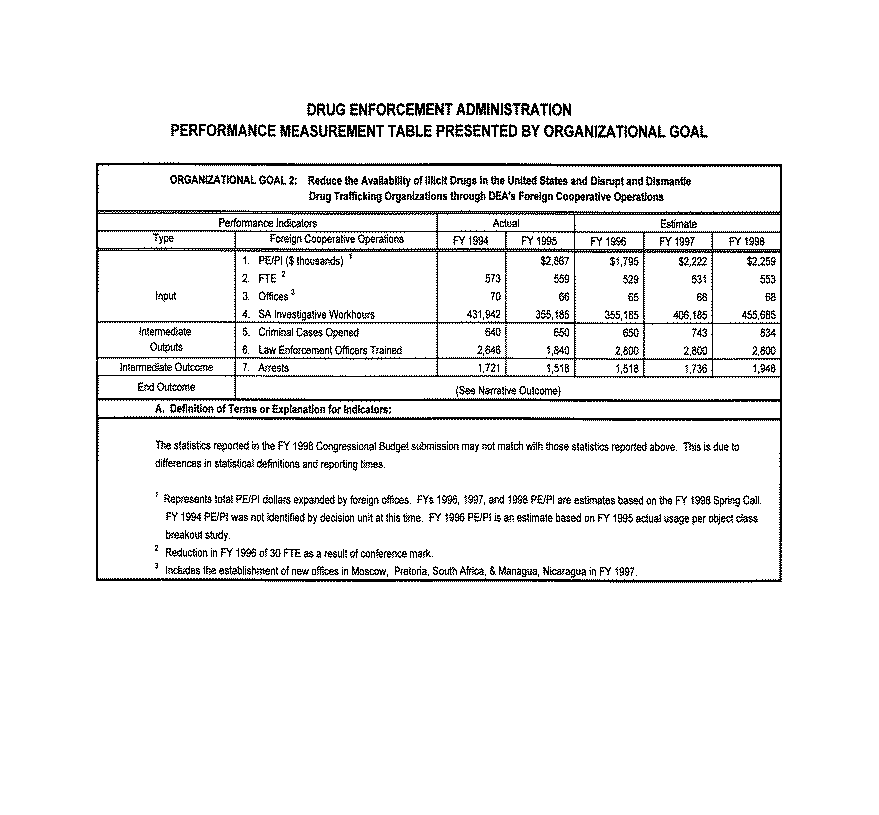 FOREIGN
COOPERATIVE OPERATIONS
FOREIGN
COOPERATIVE OPERATIONS
NARRATIVE OUTCOME
The DEA's foreign cooperative operations have had a tremendous impact on drug trafficking in foreign countries throughout the world. Below are recent examples of foreign cooperative investigations.
Bogota
Operation Selva Verde is a cooperative, bilateral operation between the DEA's Bogota Country Office and the Colombian National Police (CNP) Anti-Narcotics Unit. The primary purpose of this operation is to locate and destroy clandestine laboratories, airstrips and storage sites. A secondary purpose is to form a strong narcotics intelligence and operational alliance between the DEA and the Government of Colombia. This operation has been extremely successful. The Bogota Country Office assists the CNP in developing and managing sources of information, as well as debriefing and making payments to these individuals. In addition, the DEA provides aircraft and the air intelligence group as aerial intelligence platforms to support this program.
During 1996, four major cocaine hydrochloride (HCL) laboratory sites were identified and destroyed. Three of the sites were destroyed by the CNP in cooperation with the Bogota Country Office in Operation Selva Verde. The fourth site consisted of an HCL laboratory and a separate stand-alone large chemical synthesis complex. This fourth laboratory site was identified and destroyed by the Colombian Army after a site visit by the DEA.
Costa Rica
In October 1996, information was developed by the DEA and the Organization of Judicial Investigation on a group of Costa Rican and Colombian traffickers smuggling cocaine from Barranquilla to Costa Rica. An intercept determined that approximately 300 kilograms of cocaine had already arrived in Costa Rica by vessel. After arresting the main suspect and searching his residence, a warehouse was located revealing 389 kilograms of cocaine as well as a semi-tractor trailer truck and a tanker with Guatemalan tags. The tanker had a concealed compartment which could only be accessed when the tanker was empty. The tanker had brought a load of soap from Panama and unloaded it at the warehouse. Once the compartment was loaded with cocaine, the soap would surround the compartment to conceal the cocaine.
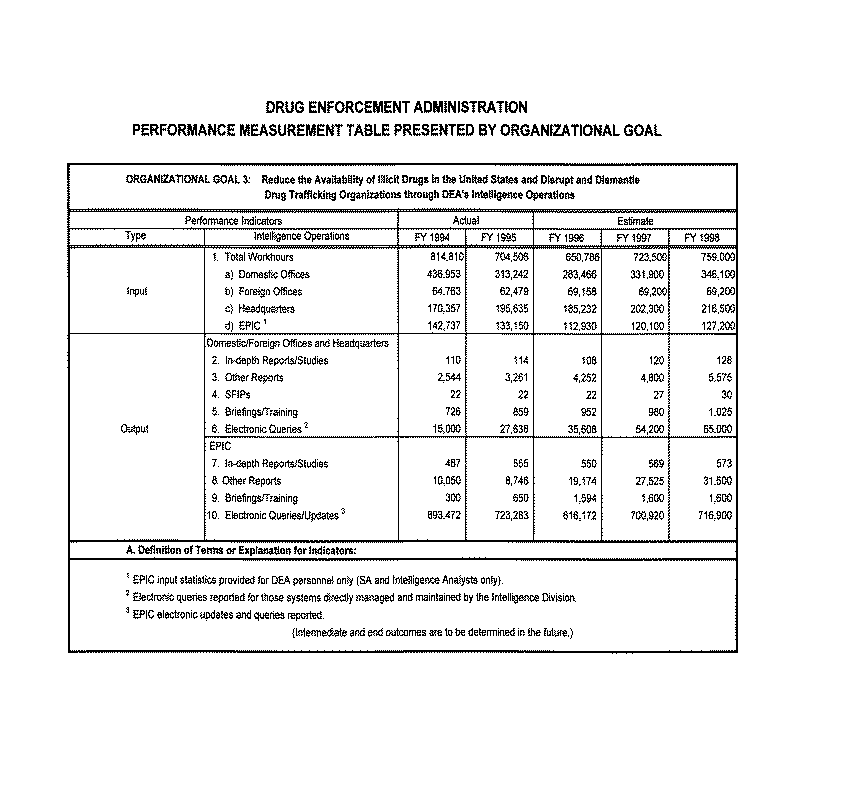
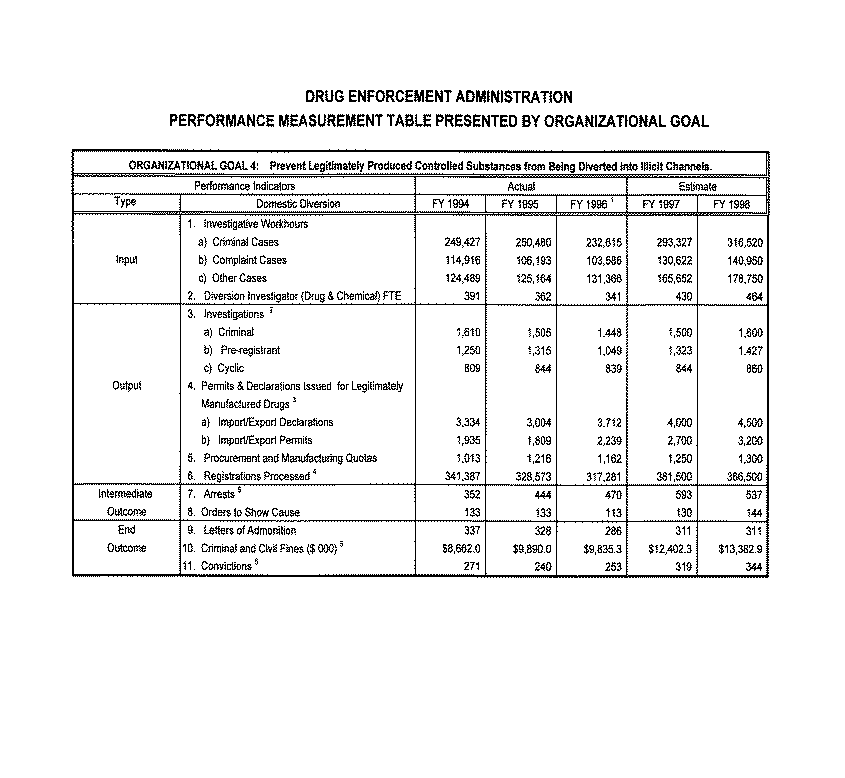
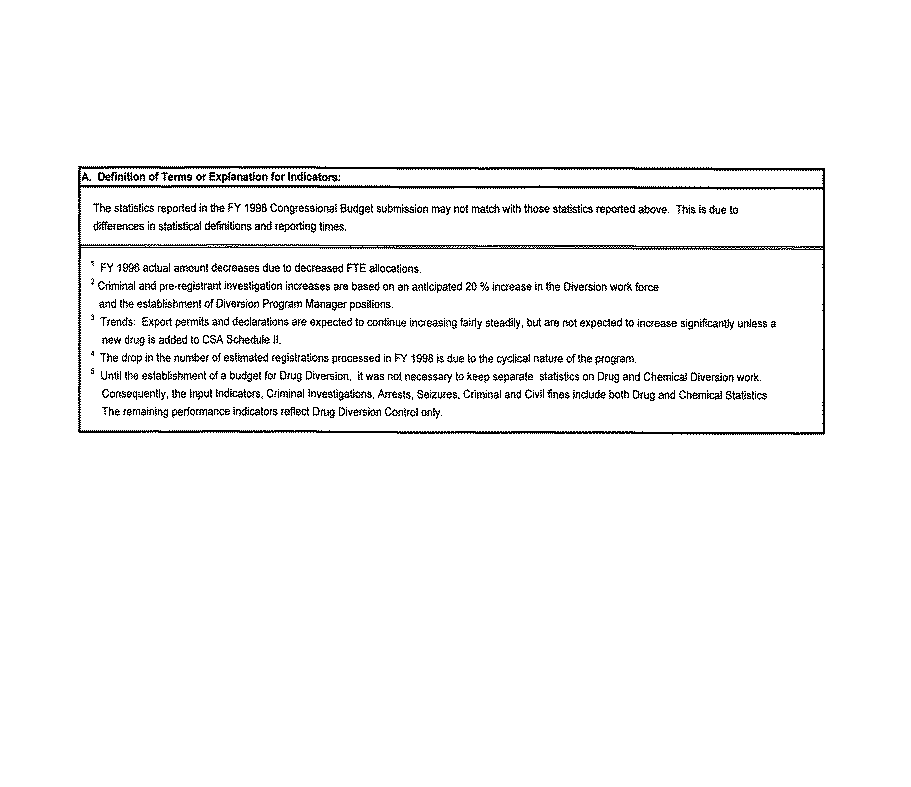
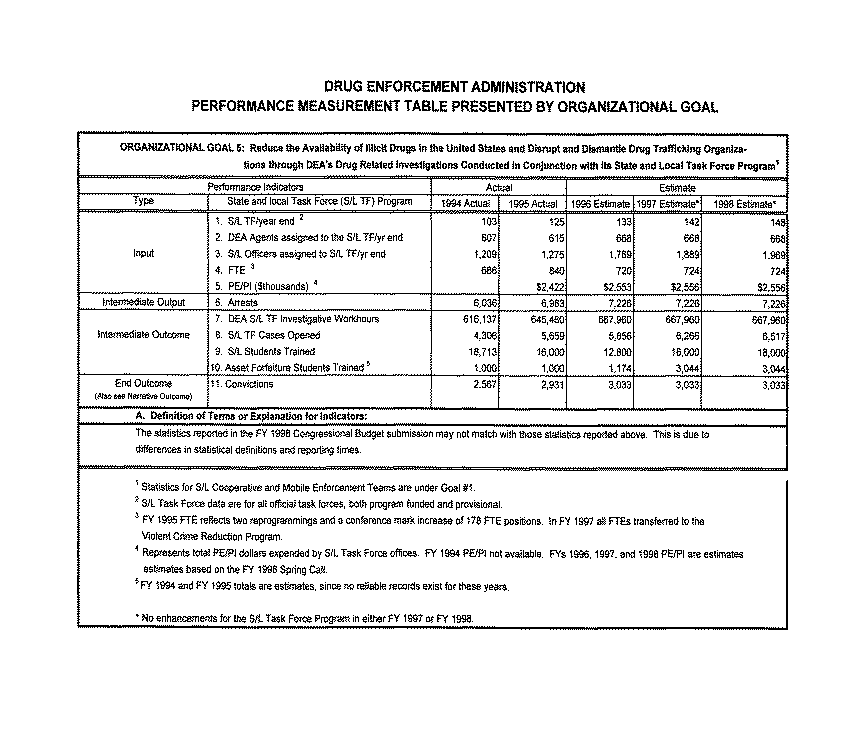
STATE AND LOCAL TASK FORCE PROGRAM
NARRATIVE OUTCOME
Expansion of Jurisdiction
Since State and local agents participating in DEA task forces are deputized to perform the same functions as DEA agents, their jurisdictional boundaries are expanded. Without this deputization, State and local law enforcement officers find that their jurisdiction to investigate drug cases stops abruptly at their State, county, or city borders. This expanded jurisdiction is imperative in investigating narcotics cases because drug dealers know no boundaries.
Shared Intelligence
The information shared by the Federal, State, and local investigators is crucial to a successful drug investigation. Local drug agents know their communities--the dealers, their methods, their hangouts. Combining this local knowledge with the DEA's broader expertise in drug investigations produces positive results. Often an area's drug agents--Federal, State, and local--each hold a piece of the intelligence puzzle, and sharing these puzzle pieces can more quickly produce a complete picture.
In one example of cooperative law enforcement, from 1991 to 1992 the DEA worked with the Savannah, Georgia, Police Department; Chatham County Metro Drug Squad; the Bureau of Alcohol, Tobacco, and Firearms (ATF); the Internal Revenue Service (IRS); and the U.S. Marshals Service (USMS) to arrest members of the Ricky Jivens organization, a violent drug trafficking gang. The investigation revealed that high-level members of the organization were required to commit murder as an initiation rite to secure their positions in the gang. Video surveillance recorded Jivens telling an informant to murder "any" person, regardless of their connection to the gang. The task force collected evidence to aid in prosecuting at least seven homicides, as well as thwarting widespread drug-related violence by causing the indictment of eighteen gang members. Several gang members were indicted and the organization leader, Jivens, was sentenced to life imprisonment and a $1 million fine.
Experience/Training
Bringing together all levels of law enforcement enhances training and provides invaluable experience to law enforcement. Most law enforcement agencies have few dollars to spend on training. Therefore, most training is received on the job. Researching a criminal history, tracking down leads, analyzing pen registers, preparing a case with an Assistant United States Attorney, identifying drugs, prices and trends are skills learned more quickly when an experienced officer works closely with a new officer. Task forces bring together groups of officers with a variety of expertise, such as knowledge of Organized Crime or established Confidential Informants, making cost-effective use of their knowledge.
Coordination
Relationships formed by the DEA State and local task forces facilitate coordination. During an undercover drug buy, it is not unusual for a local task force officer to communicate with a marked police car, telling the car to leave the area. Surveillance assistance is another benefit of a close association of Federal, State, and local officers. Many times a subject of surveillance is observed with an unidentified person. Rather than reveal the surveillance, a local task force officer can quickly call in a traffic officer, who then makes a routine stop of a vehicle and subtly identifies the person.
Coordination also prevents duplication of effort, thus saving countless dollars. When drug agents get together to coordinate activities, they frequently find that several different agencies have been investigating the same dealers and can then make more efficient use of their time and resources.
Asset Forfeiture
Participating in joint operations allows State and local law enforcement to share equitably in assets seized from drug dealers. During FY 1992, State and local law enforcement received approximately $230 million in forfeited cash and $12.5 million in tangible property from Federal forfeitures. With law enforcement resources scarce, these equitably shared funds go far in fighting crime at all levels.
Sometimes a seizure benefits the entire community. Atlanta's State and local task force seized 35 acres of property in the heart of the city, appraised at $538,500, and seized an additional $73,579 in cash. The United States Attorney and the DEA's Special Agent-in-Charge agreed that because of the property's beauty and rarity, they should find an alternative to selling it. Although the task force agreement provided that the proceeds from seizures would be shared equally among the 12 State and local agency task force participants, all 12 agencies waived their rights to the property. After several months of planning and negotiation, title to the property was transferred to the Georgia Sheriff's Youth Homes, a non-profit organization sponsored by the Georgia Sheriff's Association. The Youth Homes will provide drug education to children, sponsored by each of the 12 task force agencies through a summer camp program. Nature trails and a nature science center will also provide education to children from schools within the 12 jurisdictions.
FISCAL YEAR 1996 PROGRAM HIGHLIGHTS
MOBILE ENFORCEMENT TEAMS (METs)
The Mobile Enforcement Teams (MET) initiative deploys quick response teams at the request of local police chiefs, sheriffs, or other law enforcement entities. Teams work directly with local law enforcement to conduct investigations, obtain indictments, and help with arrests before returning to their base divisions.
Specific objectives of the METs initiative are to:
The MET program, initiated in May 1995, is a highly successful and sought after tool by local law enforcement. Through FY 1996, the DEA received 149 MET requests nationwide. A total of 77 deployments were made across the country; 52 were completed. The statistics resulting from these initial deployments are impressive and include over 2,500 arrests, along with substantial seizures of drugs and assets. As a result, many violent neighborhood drug gangs have been dismantled, their leaders and members prosecuted and imprisoned, and a sense of control by local law enforcement reestablished. During FY 1996, 47 MET deployments were completed across the United States.
Sixty-four MET requests are under evaluation for future deployment. From the FY 1997 appropriation, the DEA allocated 130 Special Agent positions and 33 support positions to supplement the existing MET units and create a second MET in four divisions.
THE SOUTHWEST BORDER INITIATIVE
To implement investigative agency efforts under the Department of Justice's Southwest Border Initiative, the DEA, working in concert with the Federal Bureau of Investigation (FBI) and the United States Attorneys Offices, has developed and implemented an integrated, coordinated plan for law enforcement counterdrug activities along the U.S. Southwest Border (SWB). The investigative agencies, which include the U.S. Customs Service (USCS), have focused intelligence and enforcement efforts, and resources to conduct simultaneous investigative activities in cooperation with the Government of Mexico (GOM) on both sides of the SWB.
The SWB investigative agency plan provides for a regional concept for intelligence sharing, cooperative investigations, and coordinated enforcement activities of the Federal investigative agencies, the SWB HIDTA partnerships, and other State and local task forces. The DEA, FBI, and USCS, with support from other Federal, State, and local agencies, are targeting major trafficking groups. Further, the DEA, the FBI, and the USCS are providing advice, operational planning, intelligence, and training to the GOM law enforcement authorities to strengthen their institutional capabilities.
DISMANTLE MAJOR DRUG ORGANIZATIONS
Colombia
The DEA worked with its international partners to bring the world's most notorious drug traffickers to justice. During 1996, the Colombian National Police (CNP), with assistance from DEA, apprehended seven Cali Mafia leaders. One of these individuals, Jose SANTACRUZ-Londono escaped from Bogota's La Picota prison on January 11, 1996. However, on March 5, 1996, SANTACRUZ-Londono was subsequently shot and killed outside Medellin, Colombia.
Victor PATINO-Fomeque, considered the fifth leading figure in the Cali drug mafia hierarchy, was sentenced to twelve years in prison on drug charges and for his involvement in the killing of a Colombian naval officer. His sentence is considered to be one of the harshest handed down in Colombia against a major drug figure. The DEA records indicated that PATINO had been involved in cocaine and heroin trafficking as early as 1986, and that he allegedly directed an eight-ton cocaine shipment to New York.
Juan Carlos RAMIREZ-Abadia, a second-generation Cali Mafia leader, turned himself into Colombian authorities on March 15, 1996. Since the 1980's, RAMIREZ reportedly has been responsible for the importation of twenty metric tons of cocaine into the U.S. He was sentenced to twenty-four years in prison, but because of Colombia's lenient sentencing laws, he will serve no more than thirteen years and four months in prison, and could serve as little as seven and a half years.
Thailand
Operation Tiger Trap fugitive CHAO Yu-an was arrested on April 17, 1996 by the Royal Thai Police and the DEA. CHAO Yu-an, a member of the Shan United Army, has allegedly coordinated heroin shipments since the 1980s. He was indicted in June 1994 for heroin trafficking in the Eastern District of New York. On August 31, 1996, CHAO Yu-An was extradited from Thailand to the Eastern District of New York and is currently cooperating with the U.S. Attorneys Office. Further judicial proceedings were suspended pending full debriefings and the outcome of his cooperation.
Cuba
In August 1996, the DEA's Miami Field Division identified the M/V LIMERICK and the M/V MARSHALL as being utilized by the Carlos TASCON cocaine trafficking organization to transport multi-ton quantities of cocaine from the ports of Barranquilla and Cartagena to numerous pre-determined locations in the Windward Passage. Upon arriving at this location, the M/V LIMERICK and M/V MARSHALL would off-load their shipments of cocaine to "go-fast" or fishing type boats who then transported the cocaine shipment to Miami, Florida for distribution.
On October 1, 1996, a Coast Guard cutter located and boarded the M/V LIMERICK in the
Windward Passage. The Chief Engineer of the M/V LIMERICK attempted to scuttle the boat,
thus causing the Coast Guard boarding team and the crew of the M/V LIMERICK to abandon the
motor vessel. The M/V LIMERICK then ran aground in Cuban territorial waters. Cuban
officials subsequently towed the vessel to Santiago to conduct a thorough inspection with
members of the M.D./HATTIE 4. As a result, they discovered approximately 6,000 kilograms
of cocaine contained within three hidden compartments on board the M/V LIMERICK.
The DEA Miami was allowed to transport the 6,000 kilograms of cocaine to Miami, Florida to
be utilized in the prosecution of the twelve crew members arrested from the M/V LIMERICK.
This case represented the first time Cuban officials worked with U.S. law enforcement in
an operation against drug trafficking. Cali drug leader Helmer "Pacho" HERRERA
surrendered to the CNP in September 1996. The HERRERA Organization was involved in cocaine
production, transportation, wholesale distribution, and money laundering. He remains in
jail but has not been sentenced.
France
With support from the DEA, French authorities arrested DEA fugitive John Richard KNOCK in Paris on April 17,1996. KNOCK is a major trafficker of hashish and Thai marijuana. He headed an organization that reportedly distributed over 200 tons of hashish into the U.S. and Canada between 1983 and 1993. In late October 1996, French judicial authorities authorized extradition; however, they also granted a sixty-day appeal right regarding this decision.
Nigeria
In connection with Operation Global Sea (an enforcement operation involving the DEA, U.S. Customs Service, FBI, and numerous State and local agencies), the arrests of Musiliu BALOGUN, Titilola OLUBI, Anthony SMITH, Kafayat MAJEKODUNMI, and their subordinates, served to dismantle a major Nigerian heroin distribution organization which smuggled multi-kilogram quantities of Southeast Asian heroin into Chicago; as well as to dismantle a major West African heroin source network in Bangkok.
Mexico
The four major Mexican drug syndicates headed by Juan GARCIA-Abrego, Amado CARRILLO-Fuentes, the ARELLANO Felixes, and Carlos QUINTERO, virtually control the illicit drug trade along the U.S. - Mexico border. A significant blow was dealt to these Mexican drug syndicates when Mexican police arrested mafia leader Juan GARCIA-Abrego at a villa near Monterrey on January 14, 1996.
GARCIA-Abrego was flown to Mexico City where Mexican Attorney General Lozano-Garcia authorized his transfer to U.S. custody. On January 15, 1996, GARCIA-Abrego was transported to Houston to face drug trafficking charges in the Southern District of Texas. He was subsequently found guilty of operating a Continuing Criminal Enterprise (CCE) and other charges, including money laundering. Additionally, the jury found in favor of the U.S. Government in the forfeiture of $350 million in assets belonging to GARCIA-Abrego.
In late May 1996, the Government of Mexico (GOM) expelled Jose Luis PEREIRA-Salas to the U.S. to face drug charges. During questioning, PEREIRA-Salas confessed that he had been directly involved in three cocaine shipments totaling twenty-seven metric tons, while working for the Miguel and Gilberto RODRIGUEZ-Orejuela organization in Mexico.
IDENTIFICATION OF EMERGING MAJOR DRUG THREATS
Methamphetamine
Methamphetamine use and trafficking has been spreading across the country in recent years, initiating a ruinous cycle of drug addiction and crime. Reporting from State and local police, as well as DEA's own intelligence, has discerned methamphetamine's reach into areas of the Northwest, Midwest and Southeast. Mexican drug trafficking groups have displaced outlaw motorcycle gangs as the principal producers and suppliers of methamphetamine in this country. In recognition of the need to respond to this threat, the DEA assembled over two hundred representatives from Federal, State and local law enforcement agencies nationwide in Arlington, Virginia, from February 13-15, 1996, for a National Methamphetamine Conference.
A database describing the nature of the methamphetamine problem (from the law enforcement perspective) was developed based on conference participants' responses to a comprehensive survey of questions related to methamphetamine production, trafficking and use. Seven working groups were established to allow conference attendees to raise and discuss important issues and specific aspects of the methamphetamine problem.
As a result of the conference, regional methamphetamine trends were identified, as were the polydrug trafficking groups responsible for the importation of methamphetamine into the U.S. In addition, a National Methamphetamine Strategy was developed which organizes the overall interagency, international and interstate effort, which addresses: clandestine laboratory operations, chemical diversion, smuggling, intelligence collection, enhanced resources, specialized training and operational coordination. The DEA will continue to participate in special initiatives with agencies, such as the California Bureau of Narcotics Enforcement, and others, to intensify efforts to disrupt the flow of substantial amounts of methamphetamine being trafficked by Mexican organizations operating from bases in Central Mexico, over the Southwest Border, to cities throughout the country.
Marijuana
The continuing marijuana threat has been highlighted by alarming statistics that show substantial increases in the use of the drug by the youth of our country. It has sparked a renewed call by law enforcement to counter the ever-increasing distribution of substantial quantities of the drug by highly-organized crime groups. The profits generated by the distribution of marijuana are considerable and tend to be laundered within the U.S. The U.S. continues to cultivate high-quality marijuana, which is marketed in this country. We are also the recipients of small and large consignments of marijuana from source countries outside the U.S., namely, Colombia and Mexico.
In response to this threat, during 1996, the DEA developed a Marijuana Strategy which seeks to disrupt, dismantle, and destroy the major trafficking organizations responsible for the production, transportation, and distribution of marijuana destined for or grown right here in the U.S. The strategy articulates a law enforcement approach to combating the threat posed by an increase in marijuana use and abuse which complements a national strategy that seeks to diminish--through demand reduction, education, and treatment--the number of marijuana users in the U.S. Last, the DEA provided a comprehensive written response to the Office of National Drug Control Policy regarding its official position with respect to the marijuana legalization issue.
Rohypnol
The sedate-hypnotic drug flunitrazepam has emerged as a significant abuse and trafficking problem in the U.S. It is marketed under the trade name of Rohypnol and is known as the "date rape" drug. Flunitrazepam is neither marketed nor approved for medical use in the U.S. The drug impairs mental judgement, incapacitates the user and causes memory loss.
The DEA's Office of Diversion Control instituted a special enforcement program which provided funds for Rohypnol investigations. As part of this initiative, DEA personnel traveled to Mexico and Colombia to elicit their cooperation in this endeavor. In addition, the U.S. Customs Service issued an import alert for Rohypnol. At the DEA's request, the International Narcotics Control Board of the United Nations banned the importation of flunitrazepam into the U.S. DEA has documented over 2,400 Federal, State and local law enforcement cases involving Rohypnol, and has provided this information in support of the passage of the Drug-Induced Rape Prevention and Punishment Act of 1996. As a final measure, the DEA is currently reviewing the possibility of placing Rohypnol on Schedule I of the Controlled Substances Act.
FIGHTING DRUGS
Enforcement
During August 1996, the DEA and the U.S. Customs Service (USCS) seized over $16 million in separate, but related, investigations in New York and Miami. On August 9, 1996, law enforcement authorities seized $1 million from a residence in Queens, New York and from a warehouse in Long Island. One suspect was arrested. Evidence at the scene indicated that the currency, which was concealed in hollowed-out stereo units, was destined for Miami then onto Cali, Colombia. The DEA New York forwarded this information to the DEA Miami.
On August 12, 1996, the DEA and the USCS seized $6.3 million from boxes stored in a Miami warehouse. In August 1996, investigators seized an additional $9.2 million from a vessel in a Miami harbor.
The DEA has reduced the direct flow of U.S. supplied chemicals diverted to clandestine cocaine production in Colombia. Following the President's decertification of Colombia, the DEA imposed new pre-export verification requirements on U.S. exporters in March 1996. The curtailment comes from the review of exporter-supplied customer data which identified a large percentage of known and highly suspicious connections to criminal elements within Colombia.
During FY 1996, the Office of Diversion Control initiated a special investigative program which focused on the unlawful importation of anabolic steroids. Italy was identified as a major source of supply. In cooperation with Italian authorities, the DEA and the FBI investigators identified an international conspiracy responsible for the smuggling of thousands of dosage units of anabolic steroids into the U.S. As a result of the investigation, there were 13 arrests, 167,000 dosage units seized, and $500,000 in bank accounts identified for forfeiture.
Within the past fiscal year, the Office of Training took on a major initiative in the area of Clandestine Laboratory Investigation. As a result of the major increases in methamphetamine production, the Office of Training conducted additional training for State and local departments throughout the country. The training will ensure that State and local departments are given the knowledge and equipment that is necessary to investigate the manufacture and distribution of methamphetamine.
INTELLIGENCE
The DEA has developed a highly effective team dedicated to the analysis of documents seized from the major drug trafficking organizations. The resulting intelligence has contributed in the arrests of principal figures in the Cali drug mafia. Joint efforts between DEA analysts and their counterparts in the CIA's Crime and Narcotics Center have resulted in fused intelligence products and strengthened interagency cooperation.
EPIC
EPIC produces and disseminates a wide range of periodic intelligence products to Federal, State, and local agencies. These products range from case-specific leads, to daily and weekly messages identifying current trends, and monthly, quarterly and annual hard copy assessments of drug movement trends. During FY 1996, EPIC's Research and Analysis Section disseminated 25,000 case-specific leads in support of active investigations.
In May 1996, EPIC refocused its mission and created a new Southwest Border Unit within the Research and Analysis Section to address the increasing demand for more support to agencies working along the Southwest border. The Southwest Border Unit maintains liaison with all Federal and HIDTA entities to facilitate cooperation and intelligence sharing.
EPIC's Special Operations (SPECOPS) Unit supports counterdrug operations conducted in the U.S. and abroad, often with host nation participation. In FY 1996, EPIC SPECOPS personnel monitored over 100 satellite tracks of smuggling movements in support of Federal law enforcement agencies, and assisted in monitoring more than 14 Attorney General exempt and trafficker directed operations or controlled deliveries. SPECOPS personnel were assigned temporary duty overseas in support of numerous host nation operations in Latin America, and were directly responsible for a Spanish maritime seizure of 865 kilograms of cocaine.
IMPROVED RELATIONS AMONG FEDERAL LAW ENFORCEMENT AGENCIES
The DEA worked closely with the FBI to target major drug traffickers operating along the Southwest Border. The DEA also worked with the FBI on an Executive Exchange Program, and shared offices overseas. The DEA entered into cooperative relationships through Memoranda of Understanding with the U.S. Customs Service and the U.S. Border Patrol, which have resulted in better operational coordination and cooperation with clearer mutual goals.
FIELD DIVISION ACTIONS
DOMESTIC FIELD DIVISIONS
Miami
On January 9, 1996, the DEA seized 2,575 kilograms of cocaine and arrested six members of a Cali distribution cell. The cell was responsible for the importation and distribution of multi-thousand kilogram quantities of cocaine on a monthly basis. Also seized were nine vehicles, $130,000 in cash and documents related to the group's trafficking activities over the past two years.
Los Angeles
Federal, State and local authorities concluded a major marijuana eradication effort in August 1996, resulting in the destruction of 113,000 marijuana plants. This campaign marked the first cannabis eradication effort carried out in American Samoa.
Washington, DC
On August 1, 1996, a sophisticated methamphetamine laboratory was seized at a farm by agents of the DEA Roanoke Task Force. Inside the 100-year-old barn, agents found over 1,600 marijuana plants and a sophisticated methamphetamine laboratory. The split-level modern laboratory, secured by an electronic card key, was hidden under bales of hay. The laboratory contained stainless steel counters and cabinets, refrigerators, large reaction glassware, scales, and chemicals. Three individuals were arrested and charged with conspiracy to manufacture and distribute methamphetamine and marijuana, with firearm violations, and with tax evasion and money laundering.
Operation Grand Slam II
This operation involved a four-state, fourteen-day marijuana eradication program culminating on August 12, 1996. Federal, State and local authorities from Kentucky, Ohio, Virginia and West Virginia, as well as local National Guard units, participated in this successful enforcement endeavor. Approximately 53,900 marijuana plants were eradicated and fourteen pounds of imported processed marijuana were confiscated, in addition to one methamphetamine laboratory and 22 booby traps. A total of 35 individuals were arrested as a result of this operation.
FOREIGN OFFICES
Hong Kong
The seizure of 600 kilograms of heroin on April 25, 1996, in Guangdong Province, Peoples Republic of China (PRC), and the related arrest of 26 suspects underscores the emerging trend reported by DEA Hong Kong that heroin intended for international markets is being stockpiled by trafficking groups in that province.
This seizure, which is the second largest documented in China, followed a four-month investigation. During May and June 1996, PRC authorities reported seizures of 80 kilograms, 35 kilograms, and 73 kilograms of heroin in Guangdong Province. These seizures, combined with the April seizure, represent an aggregate of 896 kilograms of heroin. This current utilization of Guangdong Province as a major heroin consolidation and storage point by some trafficking groups is a variance from their traditional use of Hong Kong.
Santiago
Law enforcement officials in Chile dismantled 2 major chemical supply organizations in early May 1996. The organizations are believed to have supplied the majority of chemicals used by cocaine laboratories in Bolivia. The operation involved the DEA La Paz and Santiago, and the Peruvian and Chilean National Police. Chilean officials arrested 6 people and seized 10 tons of chemicals.
Lima
From July 16-22, 1996, the Peruvian National Police (PNP), in conjunction with DEA Lima, launched an operation against the CARDENAS-Guzman cocaine trafficking organization. The result was the arrest of 23 of its members as well as two PNP police officers and three Customs officials. This investigation was the first test case for the 1996 Peruvian legislation allowing the PNP to execute controlled deliveries of narcotics and to utilize a PNP officer in an undercover capacity.
BROADEN INTERNATIONAL COOPERATION AGAINST DRUG TRAFFICKING
The DEA expanded cooperation with other governments in an effort to fight drug trafficking on a global basis. For example, the DEA increased cooperation with key countries such as Colombia, Peru, Brazil and Thailand, resulting in arrests of international traffickers and enhanced intelligence-driven interdiction efforts. The DEA enhanced enforcement efforts with Mexico to address the threat of emerging Mexican organizations.
The DEA worked with European authorities in Italy and the United Kingdom to arrest major traffickers and curtail money laundering operations. Additionally, the DEA worked in concert with India, the Czech Republic and Mexico to stop the flow of chemicals for methamphetamine production. For the first time ever, the DEA, in cooperation with the FBI, opened an office in Moscow to address new drug threats in Russia.
IMPROVE INTEGRITY CONTROLS
In May 1996, several DEA offices participated in the final phase of Operation Zorro II, an 18 month Organized Crime Drug Enforcement Task Force (OCDETF) investigation involving the combined efforts of Federal, State and local law enforcement agencies. This investigation focused on the "Mexican Federation" organizations transporting drugs across the U.S. - Mexico border and on Colombian and Mexican wholesale distribution networks in the U.S. Through the collaborative efforts of 10 Federal and 42 State and local law enforcement agencies utilizing multiple court-authorized wiretaps, the Colombian distributors' and Mexican transporters' command and control organizations were identified.
Additionally, information regarding street distributors' networks, money and cocaine stash houses, and vehicles utilized to move money and cocaine was obtained. These efforts contributed to the dismantling of the Zorro-II targeted organization in the U.S.
This highly successful operation resulted in the arrest of 182 defendants; the confiscation of 5,893 kilograms of cocaine, 1,018 pounds of marijuana and .5 pounds of crack cocaine; and the seizure of $18.3 million in assets (including $2.5 million in cash).
OPERATION SKYWEB
This is a Colombian initiative where their Colombian authorities, with the DEA support, execute airport inspections with the intent to identify aircraft smuggling cocaine along the Peru-Colombian cocaine air bridge. In 1995, 53 trafficker aircrafts were seized in Colombia and in the first 5 months of 1996, 27 trafficker aircrafts were seized in Colombia.
OPERATION JETWAY
This successful EPIC-supported domestic airport interdiction program contributed to the following seizures in the nation's airports in FY 1996: 2,615 kilograms of cocaine; 64 kilograms of heroin; 32,867 kilograms of marijuana; 171 kilograms of methamphetamine; 45 firearms; and over $43 million in currency and other monetary instruments. During FY 1996, the DEA trained over 1,300 State law enforcement personnel under this program.
OPERATIONS PIPELINE AND CONVOY
These highly successful EPIC-supported national highway interdiction programs have had a significant impact on the domestic movement of drugs and drug-related currency. Results for FY 1996 include the following seizures: 9,899 kilograms of cocaine; 65 kilograms of heroin; 113,474 kilograms of marijuana; 314 kilograms of methamphetamine; 302 weapons; and over $42 million in currency and other assets. Over 3,000 law enforcement officers were trained in concealment techniques in FY 1996.
NEW DOMESTIC FIELD DIVISION
The Caribbean Field Division was established during 1996. San Juan, Puerto Rico was elevated to division status because the area was becoming a major cocaine transshipment corridor for both air and maritime smuggling. The current Special Agent staffing level is 62 positions, with a recommendation to add another twenty agents in the next fiscal year.
RECRUITMENT
Between October 1995 and September 1996, a total of 418 Special Agents graduated from ten training classes.
OFFICE OF THE INSPECTOR GENERAL, AUDIT DIVISION
ANALYSIS AND SUMMARY OF ACTIONS NECESSARY
TO CLOSE THE REPORT
Independent Auditors' Report on Internal Controls:
Recommendation Number:
Independent Auditors' Report on Compliance with Laws and Regulations:
Recommendation Number:
#####